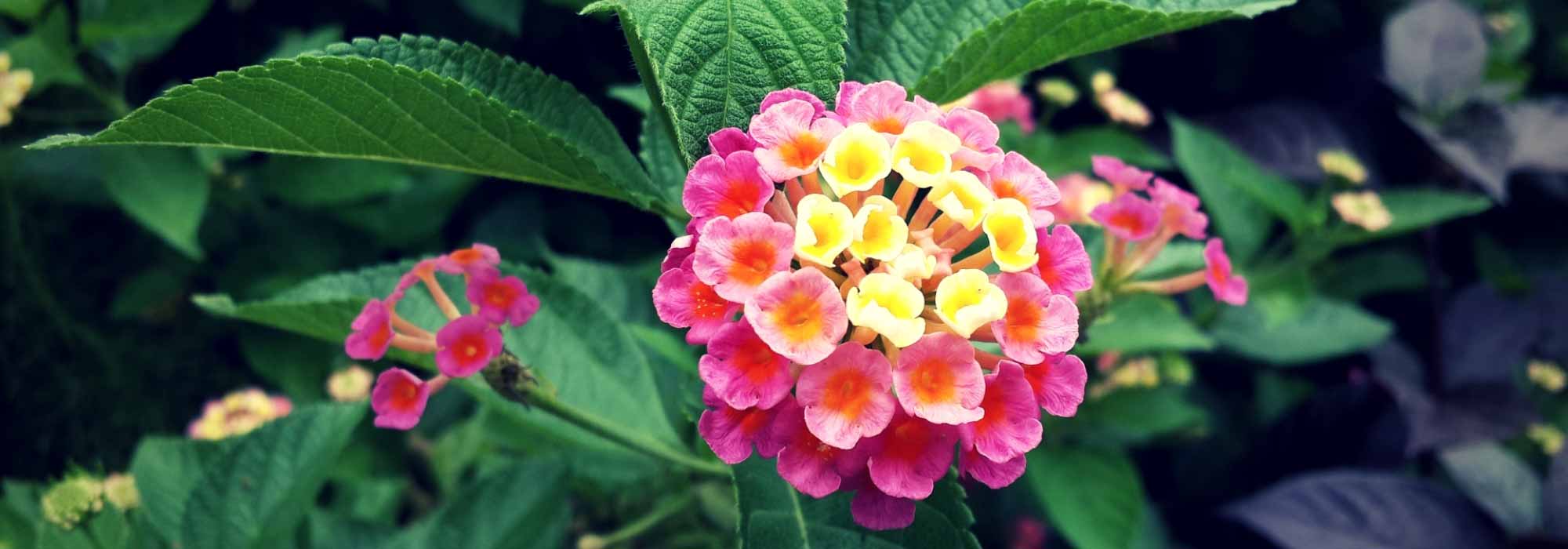
Lantana: planting and care
Contents
Lantanas in a nutshell
- Lantana is a small shrub with a bushy habit that flowers from spring until the first frosts, or even almost all year round in very mild climates.
- It offers a long flowering period with round clusters of red, yellow, pink, or even lilac and white flowers, with shades changing as they bloom.
- It is resistant to summer drought, and some varieties can withstand short frosts.
- It is not demanding regarding soil type and requires full sun to thrive.
- In mild climates, it flourishes in beds and will be grown in large pots or window boxes elsewhere.
A word from our expert
Capable of flowering almost all year round in very mild climates, the Lantana is a small, floriferous shrub that offers a long flowering display in vibrant shades of orange-yellow, pink, or mauve: a myriad of shimmering umbels supported by aromatic and evergreen foliage during mild winters.
The Lantana camara, the most common species, has given rise to numerous cultivars with colours that easily complement any garden. From orange Lantana to yellow or pink Lantana, including creeping Lantana, they provide a colourful and original decoration from summer to autumn, whether in borders or pots.
Most often very frost-sensitive, the Lantana can only be planted in the ground in very mild climates, as it only tolerates light frosts. Elsewhere, it is grown as an annual or as a greenhouse plant in large pots or containers.
Not demanding regarding soil type, resistant to drought and sea spray, the Lantana requires little watering and only needs full sun to thrive.
How to propagate a Lantana or train a Lantana on a stem, discover all our tips in our dedicated sheet on this bush that offers one of the brightest flowerings of summer.

Inflorescences of Lantana camara (photo Joaquim Aldes Gaspar)
Description and Botany
Botanical data
- Latin name Lantana
- Family Verbenaceae
- Common name Lantana, wayfaring tree, yellow sage
- Flowering from April-May until autumn
- Height 0.15 to 2 m
- Exposure Sun
- Soil type All, well-drained
- Hardiness -5°C-11°C
Native to the tropical and subtropical regions of Central America, South America, and South Africa, the Lantana, also known as Lantanier, Mille fleurs, or Gold basket is a perennial from the verbena family, just like verbenas, considered a persistent undershrub in mild climates, typically growing in pine forests, fallow lands, or pastures.
In Australia, Lantana has become invasive, and its cultivation is now prohibited. The genus comprises 150 species of evergreen shrubs or perennials. The most common and popular species in the genus is Lantana camara, which has given rise to many interesting cultivars and a new series of hybrids such as ‘Chapel Hill’. The Lantana montevidensis is also occasionally encountered, which is a creeping ground cover form.
From its tropical origins, Lantana has retained a significant cold sensitivity; it is perennial on the Côte d’Azur where it can remain in the ground all year round, but it is grown as an annual in other regions. However, it can live for a long time if wintered under good conditions.
It has a compact, bushy habit, sometimes very spreading, and a silhouette composed of multiple quadrangular stems often covered with short, spiny hairs. All parts of the plant are toxic if ingested. Height varies according to species and cultivars. While some species (Lantana montevidensis) or the Lantana camara from the ‘Carpet’ series have a creeping habit and form a compact cushion that can spread up to 1.2 m in width, the more upright forms will exceed 1.80 m like ‘Violet de Corse’. Others will form a beautiful bush that is wider than tall, not exceeding 30 to 60 cm in height.
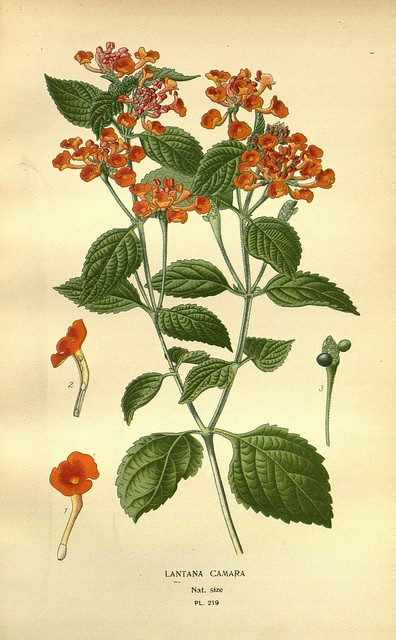
Lantana camara – botanical illustration
The foliage, aromatic when crushed releases strong and spicy scents. It will persist throughout the winter in mild climates or in a greenhouse. It consists of simple, ovate to lanceolate leaves, finely or coarsely dentate and very veined, arranged in opposite pairs or in whorls of three along the stems. Thick, slightly rough, and glossy, they are narrower at the top and measure 2 to 10 cm. Bright green to dark green, they form a lush and light setting for its fabulous flowering.
From June to October, sometimes until December if the weather remains mild, Lantana reveals its very long flowering period. Numerous small tubular flowers with 5 lobes, tightly packed in large terminal umbels 0.5 to 5 cm in diameter, bloom continuously, forming a myriad of round and vibrant bouquets in yellow, lilac, white, mauve, or pink.
Each of these ball-shaped inflorescences changes as they bloom, offering attractive colour gradients: each flower opens light and then darkens, or conversely, fades over time, ranging from white to soft yellow, from golden yellow to vermilion, from salmon pink to red or violet, or from orange-yellow to cream, depending on their degree of ripeness.
Some bouquets also alternate with small bicoloured flowers in brick red and orange yellow (Lantana camara ‘Lucky Red Flame’) or ochre yellow tinged with violet pink (‘Lucky Rose Sunrise’). All reveal a delicate contrasting little heart.
These nectariferous and melliferous florets exude a slightly lemony or peppery scent that irresistibly attracts pollinators, butterflies, and bees.
In some cultivars, flowering gives way to fruits, toxic red drupes.
Accustomed to arid, dry, and poor climates, the Lantanier requires a very sunny and sheltered position. Not demanding regarding soil type, tolerant of drought and sea spray, it prefers light, humus-bearing, well-drained soils.
 Lantana flowers in several colours: Lantana camara ‘Lucky White’, Lantana camara ‘Chapel Hill Yellow’, Lantana camara ‘Lucky Red Flame’ and Lantana camara ‘Lucky Rose Sunrise’.
Lantana flowers in several colours: Lantana camara ‘Lucky White’, Lantana camara ‘Chapel Hill Yellow’, Lantana camara ‘Lucky Red Flame’ and Lantana camara ‘Lucky Rose Sunrise’.
Exceptionally hardy, it can only survive the winter outdoors in mild climates. In harsh regions, it will be grown as an annual to be stored possibly in winter to preserve it, in pots or containers to flower a windowsill, balcony, or terrace.
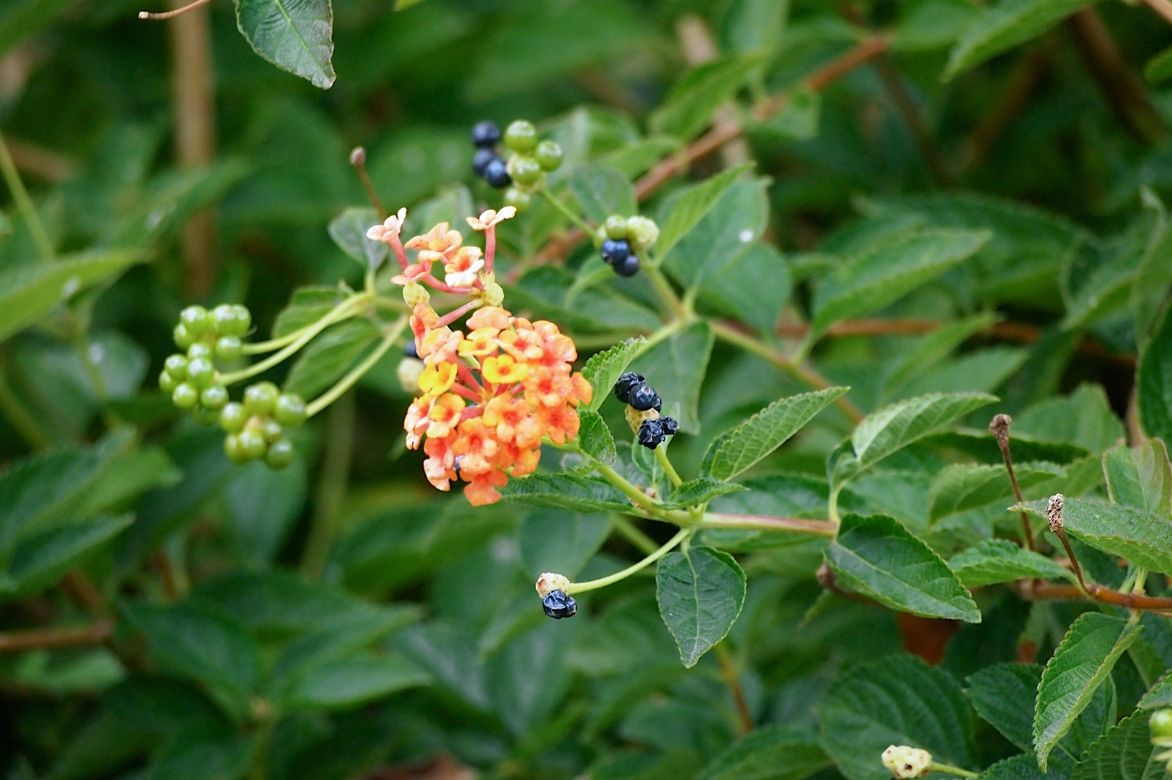 Flowers, leaves, and fruits of a Lantana camara (photo caligula1995 – Flickr)
Flowers, leaves, and fruits of a Lantana camara (photo caligula1995 – Flickr)
Main species and varieties
In our gardens, the most represented species of the genus is the Lantana camara which has given rise to many interesting cultivars and series of hybrids varying in habit as well as hardiness. We thus encounter very compact forms perfect for pot cultivation, creeping lantanas, as well as new varieties selected for their hardiness such as the Lantanas from the ‘Sunshine’ series (‘Chapel Hill Yellow’, ‘Chapel Hill Gold’, and ‘Sunny Side up’), which, unlike the usual varieties, are not solely reserved for our mildest climates and are resistant to short frosts of around -10°C in well-drained soil.
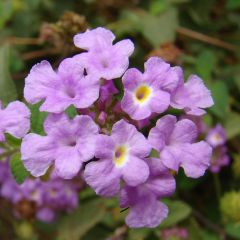
Lantana montevidensis Mauve
- Flowering time July to November
- Height at maturity 60 cm
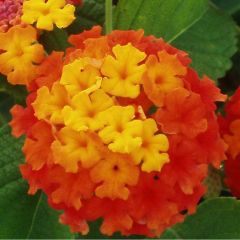
Lantana camara Evita Red imp. - West Indian Lantana
- Flowering time August to October
- Height at maturity 40 cm
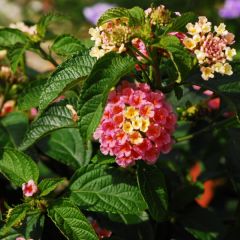
Lantana camara Evita Rose - West Indian Lantana
- Flowering time August to November
- Height at maturity 40 cm
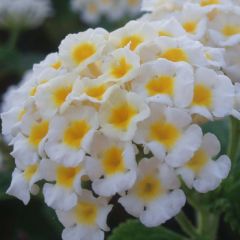
Lantana camara Evita White - West Indian Lantana
- Flowering time August to October
- Height at maturity 40 cm
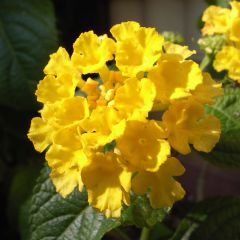
Lantana camara Evita Yellow - West Indian Lantana
- Flowering time July to October
- Height at maturity 40 cm
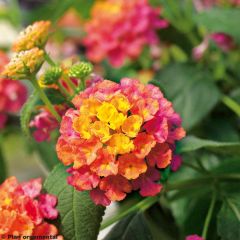
Lantana camara Calippo Tutti Frutti - West Indian Lantana
- Flowering time June to October
- Height at maturity 30 cm

Lantana camara Simon Lemon
- Flowering time August to November
- Height at maturity 40 cm
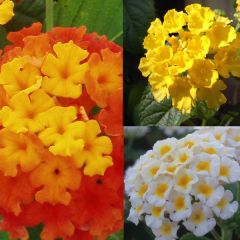
Collection of 5 red, yellow, and white Lantanas Camara
- Flowering time August to October
- Height at maturity 40 cm
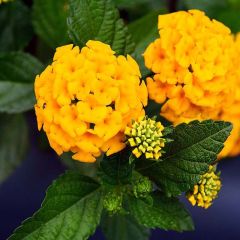
Lantana camara Chapel Hill Yellow
- Flowering time July to November
- Height at maturity 60 cm
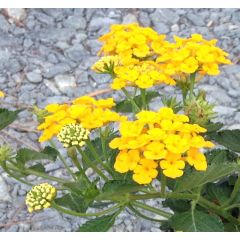
Lantana camara Chapel Hill Gold
- Flowering time July to November
- Height at maturity 60 cm
Discover other Lantana
View all →Available in 1 sizes
Available in 0 sizes
Available in 1 sizes
Available in 1 sizes
Available in 1 sizes
Available in 1 sizes
Available in 1 sizes
Available in 1 sizes
Available in 1 sizes
Available in 1 sizes
Planting Lantana
Where to plant Lantana?
Lantana is a typically non-hardy plant that only tolerates light frosts. Along the coast and in regions with mild winters, it is grown as a perennial; elsewhere, it is cultivated as an annual. This is why, if you fear frost in your area, prefer pot planting to be stored in a winter garden or heated greenhouse (10 to 15°C) and to be brought out in the beautiful season as soon as temperatures warm up, in May-June, after the frosts.
Exceptionally resistant to summer drought, pollution, and sea spray, it is, however, easy to grow in the ground all year round in southern France regions completely spared from severe frosts.
There are, however, some new exceptionally hardy varieties, such as the Lantana from the ‘Sunshine’ series (‘Chapel Hill Yellow’, ‘Chapel Hill Gold’) or Lantana montevidensis, which can withstand short frosts of around -10°C in well-drained soil and can be grown in the ground in certain regions, provided there is a thick winter mulch. After winter, hardy lantanas may take a little time to wake up; if temperatures have not dropped below -10°C, the stump will regrow, and it may sometimes be necessary to wait until June to see their revival.
While it tolerates any type of light, well-drained soil and adapts perfectly to fairly dry conditions, it will flower better in fairly fertile, deep, humus-bearing soil. Avoiding shade, it requires full sun to thrive and a sheltered position from cold winds.
Unobtrusive, Lantana is a versatile plant that adapts to all gardens and, depending on the species and varieties, to all uses. It will be planted in borders in regions with a mild climate, grown in pots elsewhere. It is a good ornamental plant for terraces and balconies.
Fast-growing, the largest lantanas can reach up to 1.80 m in height in a single season. The varieties selected for their compactness are ideal for window boxes, pots, or bowls. The most vigorous will flower in a background of borders or as edging. Spreading species like Lantana montevidensis will cover a slope, the base of a bush, or easily cascade over a wall. They are easy to train on a stem in a large pot.
When to plant Lantana?
The planting of our Lantanas in buckets or plug plants takes place in spring from March to May, after the last frosts. To ensure they flower from the beginning of summer, you can pre-cultivate them in pots in a warm, bright place to accelerate their development.
How to plant Lantana?
In the ground
To support its beautiful flowering, Lantana appreciates rich, well-drained soil: mix a light potting soil into your garden soil to enrich it and lighten it if necessary with a bit of coarse sand.
- Dig a hole two to three times wider than the root ball
- Spread a draining layer of gravel or clay pebbles
- Do not bury the plug plant too deeply
- Backfill with the enriched and lightened planting soil
- Lightly compact and water generously
⇒ Advice sheet: Growing Lantana in pots
It is the ideal plant to grow in window boxes, bowls, or pots in good rich, well-draining potting soil.
- In a pot of at least 30 cm, spread a good drainage layer
- Plant in a mixture of geranium potting soil and sand
- Water regularly during the hot season
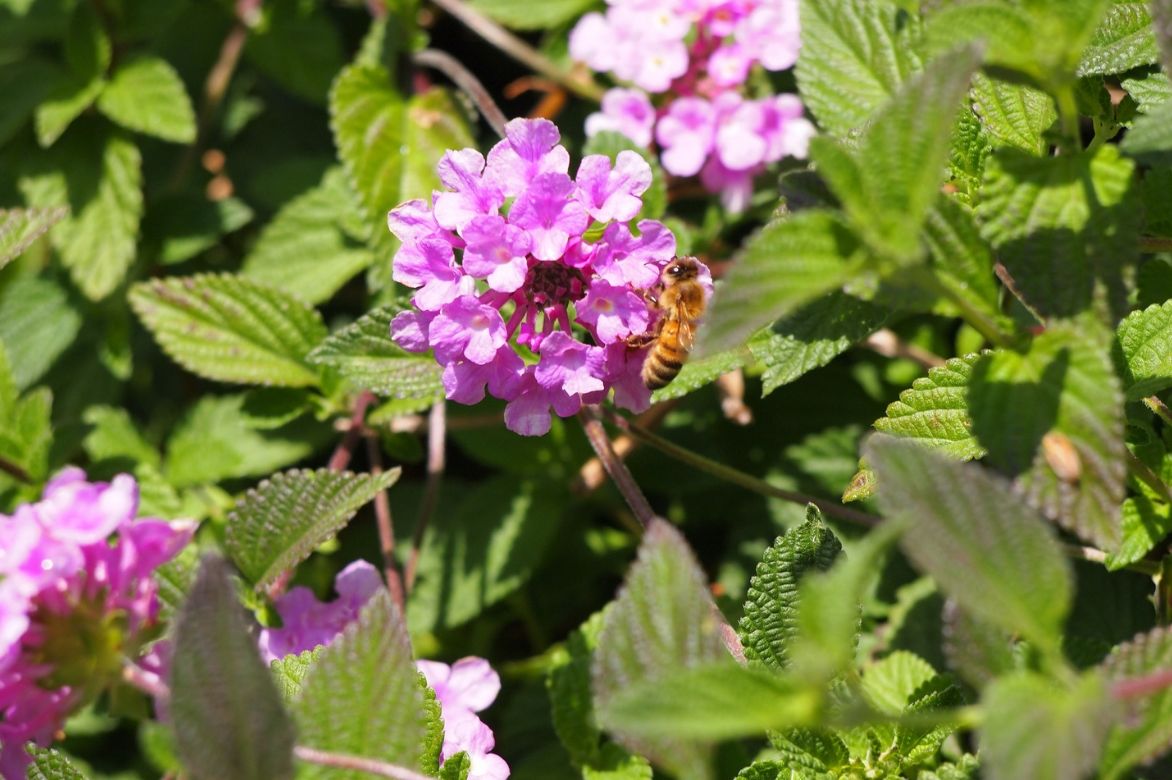
Lantana flowers are melliferous (photo caligula1995 – Flickr)
Read also
How to take a cutting from a lantana?When and how to sow Lantana seeds?
Sowing Lantana seeds is done from February to July under cover.
To sow lantanas:
- Soak the seeds for 24 hours in a glass of lukewarm water before sowing
- Sow the seeds in trays or pots filled with potting soil
- Only bury the seeds to a depth of 3 mm
- Place the seedlings in a mini greenhouse or a warm spot at 20-25 °C
- Transplant the seedlings into 8 cm pots
- Once they have hardened off, transplant them into larger pots
- Water moderately
Pruning and care of Lantanas
In the ground
These small evergreen bushes in mild climates are low-maintenance. The Lantana is quite drought-resistant and, apart from the first year after planting, it requires little watering: only water when the foliage noticeably wilts.
In regions with mild winters, protect the stump with a thick layer of straw or dead leaves.
In colder areas where Lantana is treated as an annual, pull up the clumps in autumn.
In a pot
In summer, water 1 to 2 times a week without allowing water to stagnate in the saucer and provide a liquid fertiliser twice a month. Keep the substrate almost dry in winter and stop fertilising.
If you want to keep this delicate perennial like a conservatory plant, follow our advice: Lantana: how to winter it?
When and How to Prune a Lantana?
- During summer, remove faded flowers as they appear to encourage the emergence of new ones.
- Pinch (cut the tips with your fingers) the stems in spring to promote branching.
- Remove stems that compromise symmetry.
Plants grown in a greenhouse require severe pruning in February-March to restart growth and remove dried branches: cut back to ¾ of their length, to 1 or 2 buds on each stem of potted Lantanas.
How to Prune a Lantana into a ball shape?
A Lantana can maintain its natural shape or be trained on a stem from a young plant about thirty centimetres tall. It can grow to a maximum of 2 m in about 5 years, taking time to form its trunk.
- Place in a pot wide enough to accommodate a stake.
- Choose the straightest and most vigorous stem and insert the stake nearby.
- Remove the secondary stems at the base so that only one main stem remains.
- Completely remove the lower leaves.
- Then tie the stem as it grows.
- Regularly cut back lateral branches.
- Prune regularly to form a nice ball at the top.
- Cut the terminal bud to stop growth at the desired height.

Diseases and potential pests
Lantana is rarely parasitic or diseased. In greenhouses, it is particularly sensitive to whiteflies (aleurodes) that concentrate on the undersides of the leaves. Make sprays of soapy water or nettle manure.
Brown spots on the leaves may be caused by red spider mites: cut and burn the affected parts, spray water under the leaves and on the stems, then make regular sprays with nettle manure.
When and how to take Lantana cuttings?
If sowing is possible, Lantana is more easily propagated by propagation by cuttings in summer.
When to propagate Lantana?
At the end of summer, in August-September, take semi-woody stems, that is to say, at the time when they are lignifying and transforming from softwood to hardwood.
How to propagate Lantana?
- Take cuttings without flowers, just below a leaf
- Remove the leaves from the bottom of the stem
- Plant in pots containing a moist mixture of turf and sand
- Place the cuttings in a humid environment and protect them from frost by covering them with transparent plastic
- After 2 or 3 weeks, uncover the cuttings and keep the substrate moist
- Plant out in the following spring
- Pinch the terminal buds to encourage the plants to bush out
- Water well in the first year after planting
For more information, see our advice sheet: How to propagate a Lantana?
Associating Lantanas in the Garden
With its vibrant and original flower clusters, Lantana thrives in gardens of all styles, adding a touch of exoticism and cheerfulness. It is perfect for greening a meadow, a slightly wild area of the garden, or flowering a lush mixed border.
In a well-drained bed, it will pair beautifully with exotic perennials such as Hesperaloe parviflora and Epilobium canum, alongside red or purple-tinged foliage like that of a cordyline or a canna, which will quickly adorn itself with orange flowers that harmonise perfectly with those of the lantana, or with other small flowering bushes like Helianthemum, bushy wallflowers, lavenders, cistus, or Salvia greigii. It can be planted en masse at the foot of a castor oil plant with reddish leaves.
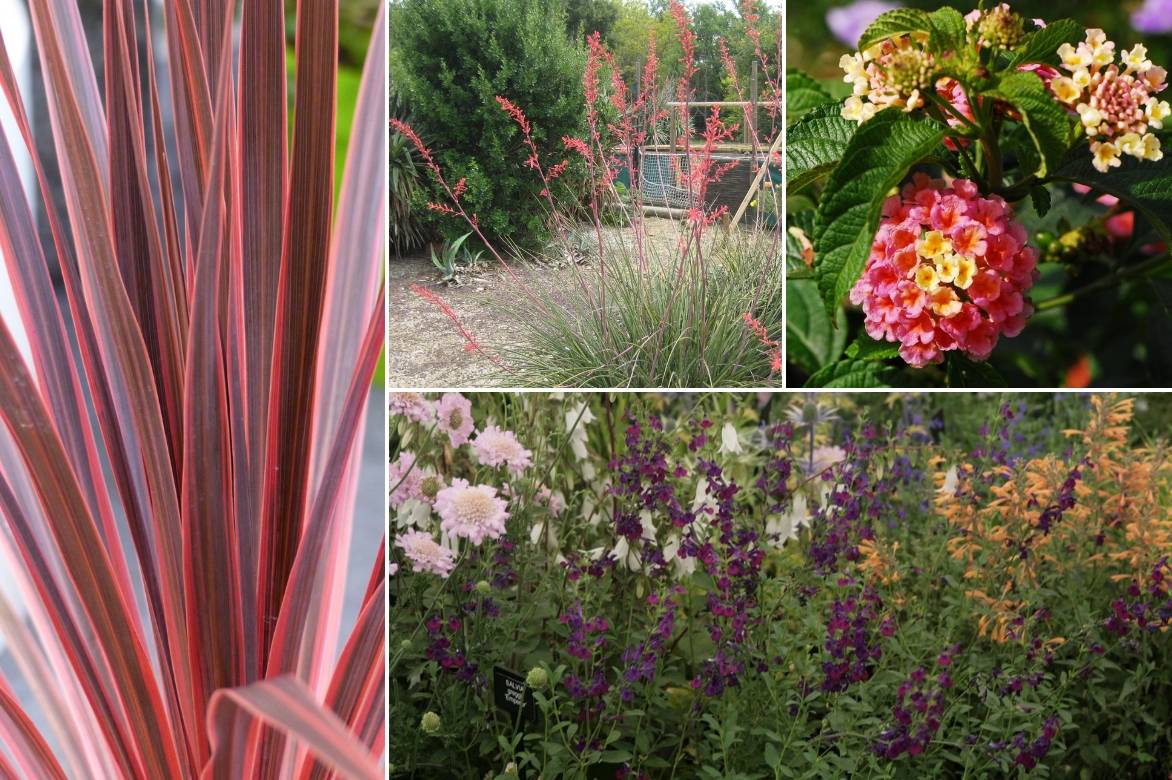
An idea for an exotic pairing: Cordyline australis ‘Charly Boy’ (a variety close to ‘Sunrise’), Hesperaloe parviflora ‘Rubra’, Lantana camara ‘Lucky Rose Sunrise’, Salvia greiggii
It is often found in contrasting yellow/blue combinations or in shades of pink for romantic or vibrant compositions.
In a border, the yellow Lantana inflorescences will mingle with the blue flowers of agapanthus, Peruvian heliotropes, Ageratum, perennial flax, aubrietas, campanulas, or a Plumbago capensis.
Pink varieties of Lantana will look stunning in a border, in front of a mass of Callistemons, hybrid verbenas, or gauras.
For a sunny yellow display, it will thrive in a rockery, on a slope with wallflowers, Coreopsis, helianthus, large variegated grasses, bronze sedges, or Pennisetum.
→ Discover 7 more great ideas for pairing lantanas in our advice sheet!
Useful resources
- Discover all our annual flowers in plug plants!
- Annual plants, which varieties to choose, let yourself be inspired by our blog
- Azure sun, Happy trend or pink garden, with our Lantanas anything is possible!
- Subscribe!
- Contents
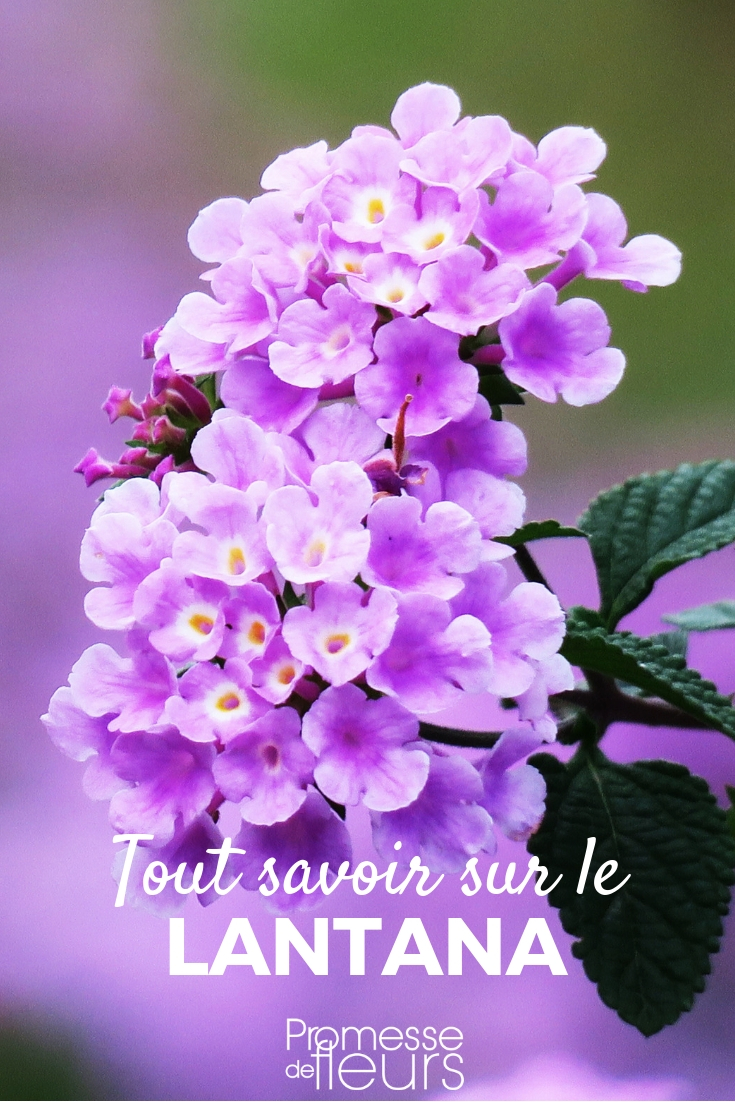

































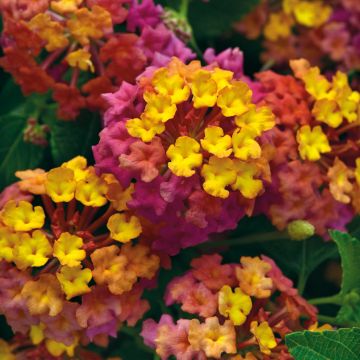

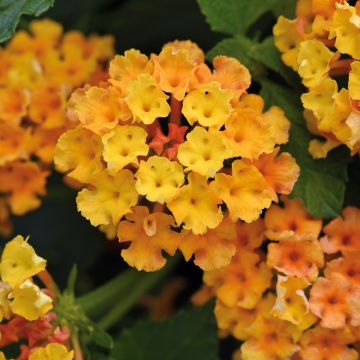

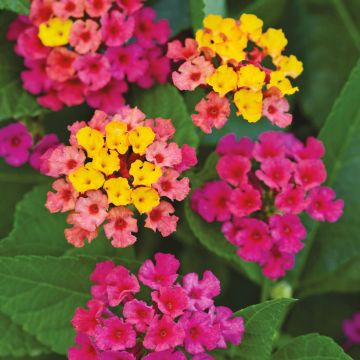
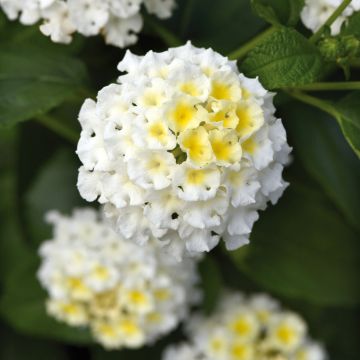
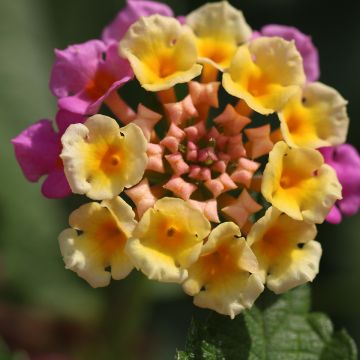
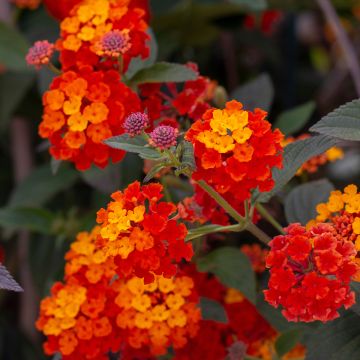
Comments